Brookfield® Gala
(USPP #10,016) Brookfield® Gala, from New Zealand, is one of the best striped Galas available with
its bold red stripe over a red background. Brookfield® Gala has consistently shown the strongest striped color we have seen
in a Gala. Early color permits proper harvest timing for best storage and flavor.
Fruit is harvested in two picks for improved packout.
|
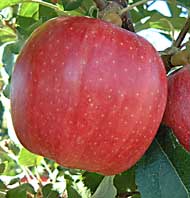
Brookfield® Gala |
Buckeye® Gala
(Simmons CV USPP #10,840) This Gala sport starts coloring a month
earlier than its parent, Imperial Gala. Buckeye® develops color well through
summer heat, and the fruit finishes with a bright, 90% - 100% full red color.
The fruit flavor, texture, size and handling qualities remain the same as its parent.
|
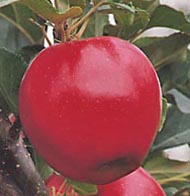
Buckeye® Gala
|
Pacific® Gala
(USPP #9681) This new, high-coloring sport of Royal Gala® has a distinctly different color and much more intense stripe overlay than Ultra Red® Gala. The completeness and uniformity of the color development seen with Pacific® Gala is very impressive. Tests have shown that Pacific® Gala stores better in both cold/CA storage than Royal Gala®.
|
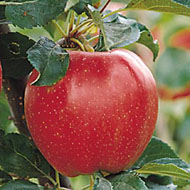
Pacific® Gala
|
Ultima™ Gala
(USPP #13,753) Discovered in East Wenatchee,
Washington, Ultima™ Gala is a limb mutation of Imperial Gala.
Ultima™ Gala has 90% - 100% red color
with a strong stripe. With its early and high color, this
Gala can be picked at proper maturity for best possible
storage and flavor retention. Other fruit characteristics
and tree growth are similar to Royal Gala.®
|
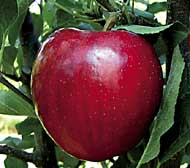
Ultima™ Gala
|
Banning Red Fuji
(USPP #16,624) Banning Red Fuji is a high-coloring, stripe type of red Fuji. Harvest timing is the same as standard Fuji
in late October. The flavor is sweet and juicy. The skin coloring is bright red with a stripe pattern.
This is one of the best stripe choices to date.
| 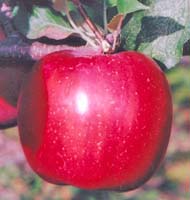 Banning Red Fuji
|
Morning Mist™ Fuji
(USPP #16,270) Morning Mist™ Fuji is an early ripening sport of Fuji which ripens in early September.
Morning Mist™ Fuji has a sweet flavor similar to standard Fuji. The color pattern is a thin striping pattern which,
in high coloring areas, might color over.
| 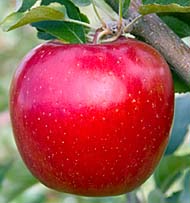 Morning Mist™ Fuji
|
Autumn Rose® Fuji
Autumn Rose® has a sweet and juicy flavor, a crisp texture and matures in late October. With
a 90% - 100% red color factor, it colors clear to the middle of the tree with a fine, visible
stripe, similar to that of Nagafu 12. This is one of the best striped choices to date.
|
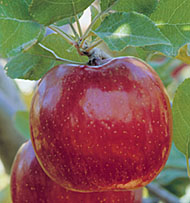
Autumn Rose® Fuji
|
Marin Red™ Braeburn
(USPP #11,604) Marin Red™ Braeburn was
discovered in Nelson, New Zealand and is a sport of
Braeburn with a full (90% - 100%) red blush at
maturity. Flesh is firm and crisp with an acid-to-sweetness
ratio like standard Braeburn. Growing
characteristics are similar to standard Braeburn except Eve®
may be slightly later in maturity. Bud union
brittleness can be a problem on EMLA 26 rootstock.
|
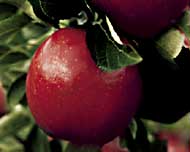
Marin Red™ Braeburn
|
Rubinstar® Jonagold
(USPP #7590) A sport of standard Jonagold with more intense and uniform color throughout the tree. It is also less susceptible to sunburn than other Jonagold strains. Tree exhibits compact growth habit. Rubinstar® ripens one week before standard Jonagold and has excellent flavor.
|
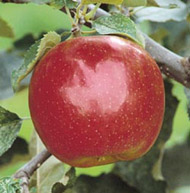
Rubinstar® Jonagold |
Midnight® Red Spur Delicious
This high-coloring sport gives you a solid, bright-red colored apple days before other Red Delicious strains.
Because of its early coloring and sizing, it fits well into the early fruit pools.
"This variety spurs up well and produces a typy apple which looks good on poorer-type years. Midnight® also has a whiter flesh than other Reds when harvested in mid-to-late August."
Earl E. Brown, Grower,
Milton-Freewater, Oregon
|
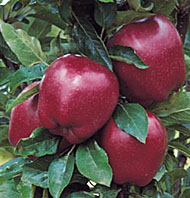
Midnight® Red
Spur Delicious |
Honeycrisp
Developed at the University of Minnesota,
this Macoun and Honey Gold cross is 50% - 90% red over a yellow background. The flesh is cream-colored with exceptionally crisp
and juicy texture, sub-acid flavor and mild aroma. A high-quality apple which keeps well for 5-6 months in common storage.
Tree is vigorous and hardy.
|
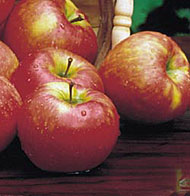
Honeycrisp |
Gibson Golden Delicious
Smooth skinned with glossy finish. The most russet-resistant Golden clone commercially available.
Fruit is firm and typy. Has excellent flavor and aroma.
|
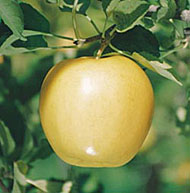
Golden Delicious
|
Acey Mac
Fruit is similar to McIntosh in appearance, taste, shape, flesh color and texture. Fruit has been noted to be larger and firmer with less preharvest drop than McIntosh. Tree is non-spur type.
|
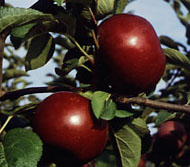
Acey Mac
|
Granny Smith
A late-maturing, long-keeping apple. Flesh is crisp and juicy with excellent tart flavor. Fruit is green and in cooler climates may develop a reddish blush. The tree is vigorous and precocious.
|
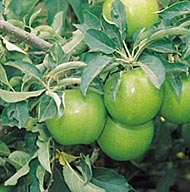
Granny Smith
|
Zestar!®
(USPP #11,367) A good-sized early season apple with above average
sweet/tart flavor. Zestar!® has 60% - 85% red on yellow background.
It can be picked in 1 or 2 pickings. Tree is spreading,
somewhat spur type with moderate vigor. A recent release from the University of Minnesota Breeding Program.
| 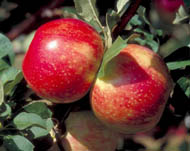
Zestar!®
|
|
POLLINIZERS |
Crimson Gold Crab
Mid- to late-season bloomer, making this a good choice for late-blooming apple varieties. The flowers are white and very abundant.
|
|
Manchurian Crab
Good pollinizer with long bloom period. Tremendous intensity of white bloom starts 2 days before Red Delicious and continues throughout the bloom period. Very susceptible to mildew.
|
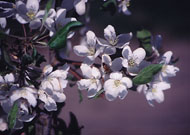
Manchurian Crab
|
Snowdrift Crab
Heavy-blooming crabapple opens a few days after the Manchurian. Good pollinizer in combination with Manchurian and Golden.
|
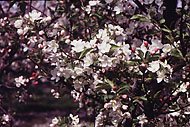
Snowdrift Crab
|
Indian Summer Crab
Blooms with king bloom of Red Delicious. Abundant pink flowers with extended bloom period. Tree is moderately vigorous.
|
|
Frettingham Crab
An excellent late-blooming pollinizer to help finish out the end of the bloom period. Tree is medium-vigor, upright and easily managed with profuse white blossoms and strong viable pollen that bees work well.
|
|
|
APPLE ROOTSTOCK
|
Listed below are descriptions of the various rootstock
presently being grown by CBN.
The two percentages immediately after the rootstock's
name are the mature fruit tree size,
first with a spur variety grown on top,
and second with a non-spur variety grown on top.
|
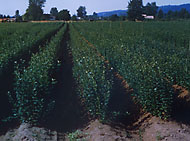 |
MM 111
(75% - 85%) Is the most hardy and wet-feet tolerant of the rootstocks listed.
A flat, shallow (18-inch deep), very fibrous root system.
BUD 118
(75% - 85%) More precocious and crops earlier than MM 111, producing a tree similar in size that does
not require support. A very hardy rootstock that was developed in a breeding program in Russia.
|
 |
MM 106
(65% - 75%) A very precocious rootstock that grows more rapidly than EMLA 7. Reports throughout the nation indicate some collar rot tendency.
| 
|
EMLA 7
(55% - 65%) The most popular semi-dwarf apple rootstock with its
heavy yields has shown wide adaptability
to many types of soils and climates.
It is more precocious than MM 106 or MM 111.
EMLA 7 is deep-rooted, but may need staking when in combination with vigorously growing, non-spur varieties.
| 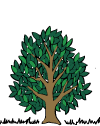
|
EMLA 26
(40% - 50%) EMLA 26 has greater winter hardiness
than M 9 and is recommended for high-density plantings. Precocity and yield
efficiency are less than M 9 but better
than that of the EMLA 7.
Trees do require support.
EMLA 26 is susceptible to
fireblight and wooly apple aphid.
Burrknots are prevalent, so trees
should be planted with the bud union no more than 1.5 to 2" above the soil line.
|

|
NIC® 29
(30% - 40%) (USPP #10,714) This superior clone from Europe,
popularly known as RN 29, produces a tree similar to EMLA 9 in size.
It appears to have more rooting capability than the EMLA 9 and transplants with less difficulty.
BUD 9
(30% - 40%) BuD 9 has similar precocity and yield efficiency to EMLA 9, producing a tree similar in size. Trees require support. It is very resistant to collar rot but susceptible to fireblight and wooly apple aphid. BuD 9 has outstanding winter hardiness and is compatible with most cultivars.
|

|
|
Save on orders of 5,000 or more trees.
Contact our office at 1-800-333-8589.
COLUMBIA BASIN NURSERY, L.L.C.
P.O. Box 458, Quincy, Washington 98848
|



